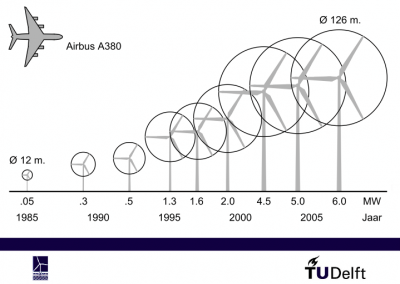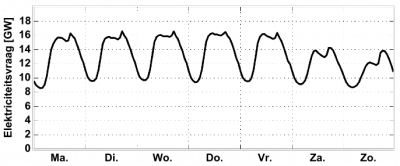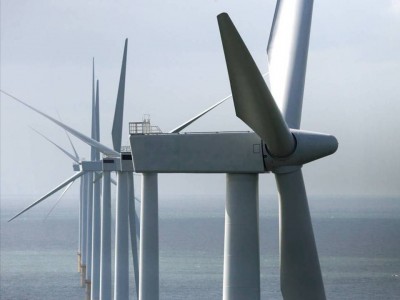 ‘The large-scale integration of wind energy in our electricity supply is technically very well feasible. The existing power system is able to cope at any time in the future with variations in demand for electricity and supply of wind power, as long as use is made of up-to-date wind forecasts. Furthermore, no facilities for energy storage need to be developed.’ These are the most important conclusions of my Ph.D. thesis, which I have successfully defended at Delft University of Technology. Below I will explain in ten minutes of reading time how I have arrived at these conclusions after four years of Ph.D. research.
‘The large-scale integration of wind energy in our electricity supply is technically very well feasible. The existing power system is able to cope at any time in the future with variations in demand for electricity and supply of wind power, as long as use is made of up-to-date wind forecasts. Furthermore, no facilities for energy storage need to be developed.’ These are the most important conclusions of my Ph.D. thesis, which I have successfully defended at Delft University of Technology. Below I will explain in ten minutes of reading time how I have arrived at these conclusions after four years of Ph.D. research.
Wind Energy
Our society revolves around electricity. Most electricity comes from electric power stations that use coal and natural gas. These are reliable and affordable fuels, but they also have disadvantages. The supply of fossil fuels is finite and unevenly distributed across the earth. Besides, conventional power stations emit greenhouse gases. There is an urgent need for sustainable alternatives, such as wind power. In the past years, wind energy has become a more and more important source of sustainable energy. Wind turbines are also increasing in size, as Fig. 1 shows. A large onshore wind turbine now delivers enough electricity to power about 3000 Dutch households (11 GWh/year), offshore this is about 5000 households (18 GWh/year). Last year, wind energy was number one with respect to the amount of newly installed generation capacity, more than gas or coal.

Fig. 1: The development of wind turbines in the past 25 years.
Variable and Unpredictable
The disadvantages of using wind as a source of electricity is that the wind is sometimes blowing and sometimes it is not and that you can’t perfectly predict it. This is difficult, because the generation of electricity must equal the demand exactly at all times. Fig. 2 provides a good example of the variations of the Dutch electricity demand for each hour and day. Conventional power plants continuously adapt their generation output to the changes of the electricity demand, and also take care of an unexpected outage of a power plant. This way, they make sure that the generation always equal the demand. Wind energy, therefore, is not the only source of variations and unpredictability, and power plants can have a sudden outage as well. Thus, wind energy is in fact not a fundamentally new challenge: what matters, is whether the conventional power plants can also handle the simultaneous variations of the demand and the wind.

Fig. 2: Electricity demand in the Netherlands, week 2, 2007.
1/3 Wind Power
In my Ph.D. thesis I have done computer simulations of the Dutch electricity system with different amounts of wind power. 12 GW, of which 8 GW offshore, produces enough electricity to cover about one third of the Dutch electricity demand. The simulations show that the Dutch power stations will be able to set off the variations in demand and wind supply at any moment in the future. This is provided that actual and improved wind forecasts are taken into account: the commitment of power plants must be re-calculated over and over again using the latest wind forecast. Then it is possible to minimize forecast errors and integrate wind energy in a better way. With wind energy, some more regulation is needed from conventional power plants, but they can handle the variations of the wind very well. Even in a situation of fast rising demand, for example during the Monday morning, a storm or a sudden wind calm do not cause any problems. Our electricity supply continues to be reliable with large-scale wind power.
Surpluses
The simulation results indicate that wind power requires greater flexibility from existing power plants. Sometimes larger reserves are needed, but more frequently power stations will have to decrease production in order to make room for wind-generated power. Instead of the often posed question ‘What to do when the wind does not blow?’, the question ‘What to do with all the electricity if it is very windy at night?’ is much more relevant. Especially during the night, when the demand for electricity is low, free wind energy will push coal-generated power out of the market. Inconveniently, however, coal-fired power stations cannot be switched off just like that. An important solution for this lies in the international trade of electricity, because foreign countries can often use this surplus. Besides, expanding the ‘opening hours’ of the international electricity market is favourable for wind power. At present, electricity companies determine how much electricity they will buy or sell abroad one day ahead. Wind power can be integrated better if the time difference between trade and the wind forecast is smaller.
Energy Storage Not Necessary
My research also demonstrates that energy storage is not required. Such an additional buffer is unnecessary for the technical operation of the power system, and the huge investment costs also make it unprofitable. The results indicate that the international electricity market is a promising and cheaper solution for the use of wind power. Making power stations more flexible is also better than storage. The use of heating boilers, for instance, means that combined heat and power plants operate more flexibly, which can consequently free up capacity for wind power at night. The use of wind power in the Dutch electricity system could lead to a reduction in production costs of EUR 1.5 billion annually and a reduction in CO2 emissions of 19 million tons a year. Coal and natural gas can’t beat that!

Fig. 3: Offshore wind park in Great Britain (© Siemens Wind Power).
References
Bart Ummels. Power System Operation with Large-Scale Wind Power in Liberalised Environments. Ph.D. Thesis, Delft University of Technology, 26 February 2009, with a general summary in English and Dutch.
B.C. Ummels, M. Gibescu, E. Pelgrum, W.L. Kling, & A.J. Brand. Impacts of Wind Power on Thermal Generation Unit Commitment and Dispatch. IEEE Transactions on Energy Conversion, 22(1):44–51, March 2007
B. C. Ummels, E. Pelgrum, and W.L. Kling, Integration of Large-Scale Wind Power and Use of Energy Storage in the Netherlands, IET Renewable Power Generation, 2(1):34–46, March 2008
B. C. Ummels, E. Pelgrum, M. Gibescu, and W. L. Kling, Comparison of Integration Solutions for Wind Power in the Netherlands, accepted for IET Renewable Power Generation, 2009
Comments
If you have any question or remark, add them as comment on this article.
I will do my best to answer them.



December 20th, 2009 at 9:13 am
It’s great to see that sometimes we need these type of things for our school work and you guys make it ready for us to use it, Thankssssssss.I think just a little bit of images are required otherwise it’s good.
January 9th, 2010 at 4:33 am
i think upcoming revolutionary industry in the globe, how to we start this business, what is the investment,how much percentage of inv, bankers are providing. and how it will gives revenue and what percentage,
March 5th, 2010 at 7:52 am
im giving presentation on this topic so can send some information plz
January 11th, 2011 at 10:40 am
i think you are mission is very importent for earth. we peopel should contrebute with you. will come to my pakistan
January 19th, 2013 at 1:14 pm
night, when the demand for electricity is low, free wind energy will push coal-generated power out of the market. Inconveniently, however, coal-fired power stations cannot be switched off just like that.”
————–
The demand for electricity is down at nights, adding generated power by wind,this would force PPs (power plants) stop production. Do you think is it feasible for the PPs to stand any more? The cost of idle times is part of the game.
4- “An important solution for this lies in the international trade of electricity, because foreign countries can often use this surplus. Besides, expanding the ‘opening hours’ of the international electricity market is favourable for wind power. At present, electricity companies determine how much electricity they will buy or sell abroad one day ahead. Wind power can be integrated better if the time difference between trade and the wind forecast is smaller.”
———-
International power trade needs development in grid as an essential infrastructure. Political relations in some parts of the globe is an issue.
Generally speaking,I need more from you to understand this article.
January 19th, 2013 at 2:02 pm
1- “The simulation results indicate that wind power requires greater flexibility from existing power plants.\
————
What sort of flexibility do you suggest here? should the PPs (power plants) stop working in regards to taking care of wind power to produce? It’s sort of mother and child relation.
2- “Sometimes larger reserves are needed, but more frequently power stations will have to decrease production in order to make room for wind-generated power.”
———
Decreasing production by PPs is not feasible. Why should the existing PPs make room for wind power to work?
3- “Instead of the often posed question ‘What to do when the wind does not blow?’, the question ‘What to do with all the electricity if it is very windy at night?’ is much more relevant. Especially during the night, when the demand for electricity is low, free wind energy will push coal-generated power out of the market. Inconveniently, however, coal-fired power stations cannot be switched off just like that.”
————–
The demand for electricity is down at nights, adding generated power by wind,this would force PPs (power plants) stop production. Do you think is it feasible for the PPs to stand any more? The cost of idle times is part of the game.
4- “An important solution for this lies in the international trade of electricity, because foreign countries can often use this surplus. Besides, expanding the ‘opening hours’ of the international electricity market is favourable for wind power. At present, electricity companies determine how much electricity they will buy or sell abroad one day ahead. Wind power can be integrated better if the time difference between trade and the wind forecast is smaller.”
———-
International power trade needs development in grid as an essential infrastructure. Political relations in some parts of the globe is an issue.
Generally speaking,I need more from you to understand this article.